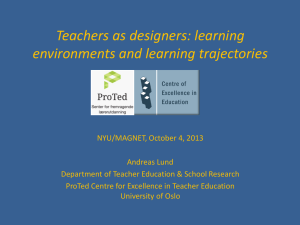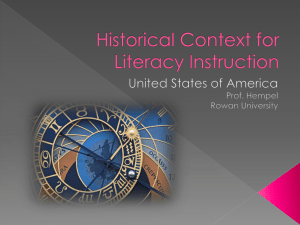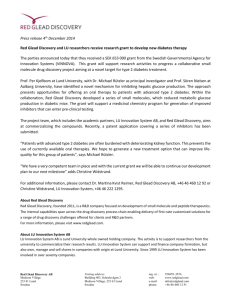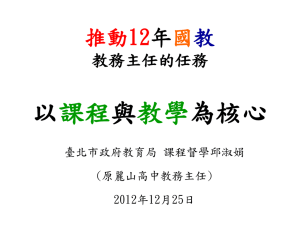Activity Theory as Design for Learning and Teaching
advertisement
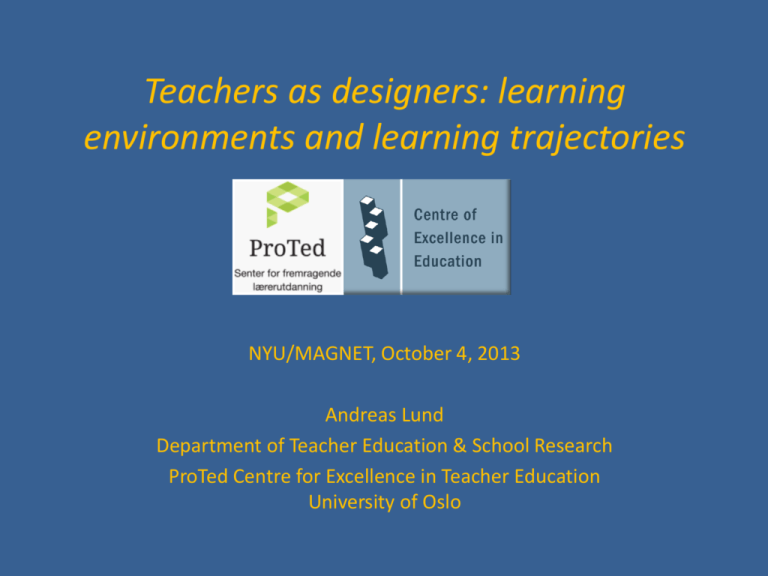
Teachers as designers: learning environments and learning trajectories NYU/MAGNET, October 4, 2013 Andreas Lund Department of Teacher Education & School Research ProTed Centre for Excellence in Teacher Education University of Oslo Some trends in teacher education • Accelerating knowledge production • Intergration: scientific disciplines, school subjects, pedagogy (didactics), theory and practice (praxis) • Rapid technological development, increased complexity, interdisciplinary problem solving, collaborative and distributed settings… • Emphasis on what counts as valid, research based knowledge • Not merely socialize student teachers into existing practices but also prepared to design new activities and practices, «Teachers as designers» • Andy Hargreaves (2003): Existing models for teacher education prevent innovation and contribute to innovative communities deteriorating • Anne Edwards (2007): «Relational expertise» - when professionals from diverse fields work together on complex problems ProTed collaborative partners Research groups National partners KIS SISCO TEPEC MESA Centre for Science education Centre for ICT in education UiO Teacher education 8-13 ProTed Centre UiO Umeå University Stockholm University Nordic partners UiT UC Berkeley LIFT School dev&Leadership UiT Teacher education 1-7 UiT Teacher education 5-10 Stanford Scientific University Advisory Board International partners Work packages for development of teacher education WP 1 Core practices: Identify/boost WP 4 WP5 Higher ed pedagogy Integrated study designs WP 3 Digital learning environments WP 2 University schools Snapshot WP3: tasks, tools, teachers and assessment • How ICT can increase quality of existing practices (lectures, seminars, practicum) • To develop new task types that integrate theory and practice, science domain and school subject, individual and collaborative efforts • To develop new assessment practices with ecological validity for the networked society Mismatch • “The explosion of new social network technologies has highlighted the awkward relationship between new ‘21st century’ media practices and existing educational systems” (Hickey et al., 2010) • Digital technologies have challenged the historically stable relationship between teachers, textbooks, tasks, and tests (Clarke-Midura & Dede, 2010) • “Mismatch” between tasks and available resources (Lund & Rasmussen, 2008) ICT as artifact ’art’ + ’fact’ representation of collective insigths entrance to cultures ’glue’ in cultures transforming cultures (activities, practises, institutions…) Teaching as design • Schön (1987) links design to professions where current practices are transformed into desirable, future-oriented practices through ‘reflection-in-action’ • To bring about connections and syntheses between situations and trajectories that are characterized by complexity, instability, value conflicts, uncertainty and the unexpected Designs for technology rich environments • Instructional design (Reiser & Dempsey, 2007) – monitoring and controlling the learner as well as the learning environment in order to bring about learning outcomes – often involved specific modules or steps – cultural tools such as e.g. textbooks, pen and paper, and calculators were considered instrumental learning aids – information processing approach – does not capture meaning making, transformation, dialogue, knowledge advancement… Design in technology rich environments (2) • Participatory design (e.g. Bødker, Kensing & Simonsen, 2004) – involving end users in the design of tools that will affect their everyday working life – focus is on the user interface design – interventionist approach – ICT and practices – philosophical roots in democracy and emancipation – no theoretical framework but recurrent concepts are e.g. boundary crossing, boundary objects, mutual learning, situated action… – Stops short of longitudinal, educational practices Sociocultural approaches to design (1) • Grabinger et al. (2007): Instructional Design for Sociocultural Learning Environments. – “critical thinking, problem solving, research, and lifelong learning” – “convergence of tools, practice and theory “ – “Do not underestimate the importance of involving students in their own instructional designs” – they rarely move beyond well established, broad terms Sociocultural approaches to design (2) • Selander (2007). A social semiotic approach: “Learning consists of, in other words, a series of sign producing activities”. – “Such designs hold material-technical as well as human-social qualities” – Didactics linked to interactivity in physical and virtual space – Designs involve preparations as well as learners negotiating their way through the design – Little/No conceptualization of practices, intentionality, object, rules, division of labor, historical development… Sociocultural approaches to design (3) • ‘Trialogical’ approach (Paavola, S., & Hakkarainen, K., 2005). • Multi-mediation (social, semiotic, conceptual, material) • Artifacts and interactions as ’drivers’ • An expanding object – not ’given’ but often at the periphery of current knowledge • Didactic dimension? Sociocultural approaches to design (4) • Hauge, Lund & Vestøl (2007, 2012): Teaching in transformation: ICT, activity, design. – Emphasis on the object in order to capture direction, collective activity, and intentionality among actors – teachers as well as learners – Objects giving direction to the activities (“predmet”) and materialize through instantiations – The unexpected, serendipity, creativity, orchestration of resources, trajectory approach, the teacher as participant in the design – Design for teaching interpreting curricula and competence aims (institutional aspects), but may well involve learners in the process – Design for learning refers to the enacted design, context sensitive, relational – Missing links between the two design dimensions, needs theorizing as well as empirical studies Missing link #1: Obuchenie • “In general, the Russian word obuchenie refers to a double-sided process, one side of which does indeed refer to learning (a change in the psychological processes and knowledge of the child), but the other of which refers to the organization of the environment by the adult, who, (…) is a teacher in a formal school with power over the organization of the children's experience” (Cole, 2009: 292). • Cf other languages (Finnish, Maori…) • Teaching | Learning - the “Sheffer stroke” capturing dialectic relationships (Roth & Lee, 2007: 197). • Video on obuchenie Missing link #2: Didactics • Networked environments: Complexity, uncertainty, collectivity, knowledge advancement; the need for instruction in the shape of informed intervention and participation • Our definition: Didactics can be understood as the design of social practices in which learners, teachers and (social and material) resources are configured and re-configured in activities that make knowledge domains and knowledge advancement visible, and that continuously create teach|learn opportunities for reflective participation in such activities TWEAK 2006 – 2011 → ? • ”Learning environments of the future” • Tweaking Wikis for Education and the Advancement of Knowledge • Unit of Analysis: the mediated activity of a collective entity Theories, tools, tasks & teachers Collective cognition A dynamic concept, emerging when two or more people reach insights that neither could have reached alone, and that cannot be traced back to one particular individual’s contribution, i.e. cannot be reduced to the sum of individual contributions (Stahl, 2006) – Sociology (Durkheim 1898, Moscovici 1998) – Philosophy (Rousseau, Levy 1997) – Social psychology (Hutchins 1995, Valsiner & van der Veer 2000, Sawyer 2007) – Linguistic/Dialogic (Bakhtin 1979, 1986, Allwood 1997, Tomasello, 2003) – Computational (Heylighen et al 2004) – CSCL (Stahl, 2006) – Educational (Mercer 2000, Hargreaves 2003) – Economics/Organization (Tapscott, 2006, Sawyer 2007) – Neuroscience: ”Mirror neurons” (Rizzolati, 1995, Ramachandran, 2006). Theories, tools, tasks & teachers Research questions • How do teachers and learners communicate when facing collectively oriented tasks? • How can we support collective cognition and communication (ccc) in classrooms? • What is the role of language? • What is the role of technologies, how can they be made conducive to ccc? – Why is not ccc a vital issue in schooling? Theories, tools, tasks & teachers S2 S1 Types of wikis/tasks Product Characteristics Tasks MediaWiki Encyclopedic a) How we perceive the USA (2 w) b) Build a typical British town (1 sem) XWiki Hierarchic + pres tool a) Impact of Anglo-American culture (2 w) Confluence Project oriented a) An immigrant story of Norway (4 w) b) Re-enacting the Cold War (2 w) c) Counter factual versions of WW1 (2 w) WikiSpaces Online ”hotel” a) A collectively written account of ESL student teachers’ placement experiences (8 w) b) ESL student teachers’ collectively produced and annotated resources (2 sem) Theories, tools, tasks & teachers Two empirical cases 3. praksiser Theories, tools, tasks & teachers Findings from Case #1: • The group struggled to make sense of contradictory information beyond their current understanding. • The use of some artifacts (props for dramatization, web-based material with affective content, etc.) threatened to replace the original object (making sense of the senseless) and become a parasitic object. Other artifacts (websites, search engines, presentation tools) proved to be conducive to knowledge advancement. • The teacher exercised only a subtle presence, leaving major decisions and final representations of the object to the learners. • The group, through negotiations and exploration, expanded their understanding of the object, but they failed to share it with their classmates. Findings from Case #2: • The ”closed task universe” (strong relationship between task and textbook, individual orientation) challenged by the “open task universe” (invites exploration, negotiation, and largescale collaboration, appears fragmented and even unreliable) • Individual and collective epistemologies - a radical shift • Mismatch between learners’ assignments and tasks and the available cultural tools • Need for assessment features in the wiki so that individual contributions as well as their relevance to the collective product are accounted for • Teachers experience difficulties of establishing a presence in a wiki. Established expertise in class management is challenged or suspended Learners’ voices: • I like this because it is a win/win situation. To help others and get help back is nice. Co-operating is very important in our daily lives and our future jobs! • I like this because we so easily can compare and share information on what we know and what we do not know about the American way of living • We never worked alone, and many helped me with my work • It doesn’t matter if it is yours or others. This way it is possible for people to argue and discuss • Because then I don’t have to be afraid of making a mistake ‘cause there will always be someone there to clear it up! • Someone can change what you have written, even when you know what you have written is correct • My texts got deleted • You socialize… in a weird way Teacher’s concerns Teacher: “(…) I lost the learners (….) it was difficult to trace, for me as a teacher, who had contributed with what, and I felt that I lost the learners, I did not know where to go in order to guide them (…) because in general there is no extensive space for a teacher (…) it becomes a separate world (…) they [learners] tend to disappear into their separate worlds and it becomes difficult for me to guide them and maintain my job as a knowledge provider. (…) I don’t know what is the end product, what I am supposed to assess at the end” 2 persons, 1 relationship 1 Add one person 2 more relationships Metcalf's law: number of links between people = n(n - 1)/2 Examples a) with 12 people b) class c) network a) 12(12 – 1)/2 = 12 x 11 = 132 / 2 = 66 possible relations b) 30(30 – 1)/2 = 30 x 29 = 780 / 2 = 435 possible relations c) 120(120-1)/2= 30 x 29 = 14280/2 = 7140 possible relations Theories, tools, tasks & teachers Theories, tools, tasks & teachers Theories, tools, tasks & teachers Two new criteria • How does your own contribution relate to the overall assignment? Show the relevance of your contribution. • How does your own contribution relate to one or more of your classmates’ contributions? Theories, tools, tasks & teachers Phase 2: The App • The Socius app is a note-sharing tool designed to bridge computerbased individual work, group work and class discussion • Design intention: 1. To facilitate preparation: Encourage students to write short notes based on their individual work 2. To facilitate sharing: The notes appearing on a tablet can be displayed on a whiteboard during class discussions 3. To facilitate participation: New notes can be added during discussion Sending twitter-like notes from essays (individual work) Discussing in groups Whole class discussion Task design Technology tools design Design for learning Design for teaching Assessment design Social design ProTed’s position: We propose socioculturally informed designs that materialize at the juxtaposition of teaching and learning, and which require that teachers participate with persistent presence in learners’ trajectories. DESIGN OBUCHENIE DIDACTICS … Teacher education • • • • Theory informed (artifacts and social dimensions) View of technology that affords transformation of existing practices Tasks, tools, activities, trajectories – and assessment! ICT links minds, hands – and maybe hearts… ”Conversation – the driver of group genius” (R. Keith Sawyer, 2007) andreas.lund@ils.uio.no Some publications • • • • • • • • • Lund, A., & Smørdal, O. (2006). Is There a Space for the Teacher in a Wiki? Proceedings of the 2006 International Symposium on Wikis (WikiSym '06) (pp. 37-46). Odense, Denmark: ACM Press. Teaching in Transformation. ICT, Activity, Design (2007).(Hauge, Lund & Vestøl). Lund, A., & Rasmussen, I. (2008). The right tool for the wrong task? Match and mismatch between first and second stimulus in double stimulation. International Journal of Computer-Supported Collaborative Learning, 3(4), 25-51. Designs for Teaching and Learning in Technology Rich Learning Environments (2011). Nordic Journal of Digital Literacy (Lund & Hauge). Changing Objects in Knowledge Creation Practices,m (2010) (Lund & Hauge). In Ludvigsen et al.: Learning Across Sites… (2009). Joint Designs for Working in Wikis: A case of practicing across settings and modes of work (2009).(Lund, Rasmussen, & Smørdal). In H. Daniels et al., Activity Theory in Practice: Promoting learning across boundaries and agencies Lund, A., & Rasmussen, I. (2010). Tasks 2.0: Education Meets Social Computing and Mass Collaboration. In C. Crawford, D. A. Willis, R. Carlsen, I. Gibson, K. McFerrin, J. Price & R. Weber (Eds.), Proceedings of Society for Information Technology & Teacher Education International Conference 2010 (pp. 4058-4065). Chesapeake, VA: AACE. (2009). VideoPaper as a Bridging Tool in Teacher Professional Development (Hauge & Norenes). Journal of Technology, Pedagogy and Education Towards an Activity-Driven Design Method for Online Learning Resources (2012) (Hauge & Dolonen). In Olofsson & Lindberg: Informed design of educational technologies in higher education .
